Related Research Articles
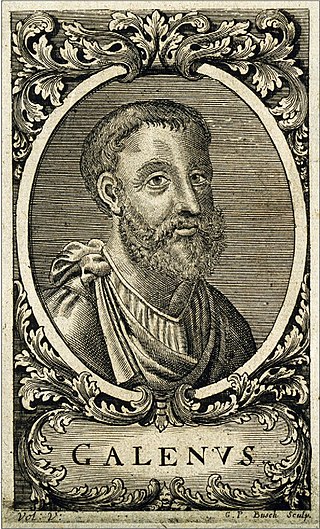
Aelius Galenus or Claudius Galenus, often Anglicized as Galen or Galen of Pergamon, was a Roman Greek physician, surgeon and philosopher. Considered to be one of the most accomplished of all medical researchers of antiquity, Galen influenced the development of various scientific disciplines, including anatomy, physiology, pathology, pharmacology, and neurology, as well as philosophy and logic.

Marcello Malpighi was an Italian biologist and physician, who is referred to as the "Founder of microscopical anatomy, histology & Father of physiology and embryology". Malpighi's name is borne by several physiological features related to the biological excretory system, such as the Malpighian corpuscles and Malpighian pyramids of the kidneys and the Malpighian tubule system of insects. The splenic lymphoid nodules are often called the "Malpighian bodies of the spleen" or Malpighian corpuscles. The botanical family Malpighiaceae is also named after him. He was the first person to see capillaries in animals, and he discovered the link between arteries and veins that had eluded William Harvey. Malpighi was one of the earliest people to observe red blood cells under a microscope, after Jan Swammerdam. His treatise De polypo cordis (1666) was important for understanding blood composition, as well as how blood clots. In it, Malpighi described how the form of a blood clot differed in the right against the left sides of the heart.
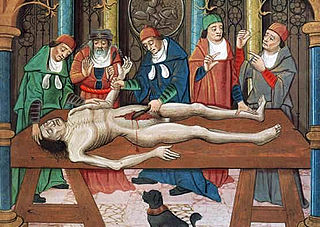
The history of anatomy extends from the earliest examinations of sacrificial victims to the sophisticated analyses of the body performed by modern anatomists and scientists. Written descriptions of human organs and parts can be traced back thousands of years to ancient Egyptian papyri, where attention to the body was necessitated by their highly elaborate burial practices.

Herophilos, sometimes Latinised Herophilus, was a Greek physician regarded as one of the earliest anatomists. Born in Chalcedon, he spent the majority of his life in Alexandria. He was the first scientist to systematically perform scientific dissections of human cadavers. He recorded his findings in over nine works, which are now all lost. The early Christian author Tertullian states that Herophilos vivisected at least 600 live prisoners; however, this account has been disputed by many historians. He is often seen as the father of anatomy.

Mondino de Luzzi, or de Liuzzi or de Lucci,, also known as Mundinus, was an Italian physician, anatomist and professor of surgery, who lived and worked in Bologna. He is often credited as the restorer of anatomy because he made seminal contributions to the field by reintroducing the practice of public dissection of human cadavers and writing the first modern anatomical text.
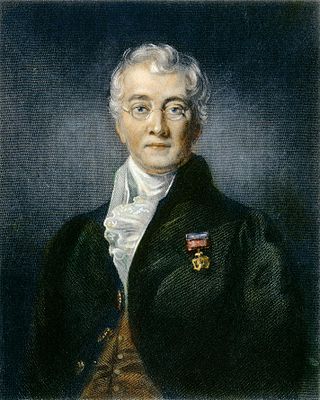
Sir Charles Bell was a Scottish surgeon, anatomist, physiologist, neurologist, artist, and philosophical theologian. He is noted for discovering the difference between sensory nerves and motor nerves in the spinal cord. He is also noted for describing Bell's palsy.

Alcmaeon of Croton was an early Greek medical writer and philosopher-scientist. He has been described as one of the most eminent natural philosophers and medical theorists of antiquity and he has also been referred to as "a thinker of considerable originality and one of the greatest philosophers, naturalists, and neuroscientists of all time." His work in biology has been described as remarkable, and his originality made him likely a pioneer. Because of difficulties dating Alcmaeon's birth, his importance has been neglected.
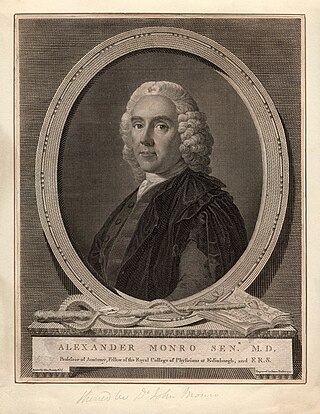
Alexander Monro was a Scottish surgeon and anatomist. His father, the surgeon John Monro, had been a prime mover in the foundation of the Edinburgh Medical School and had arranged Alexander's education in the hope that his son might become the first Professor of Anatomy in the new university medical school.
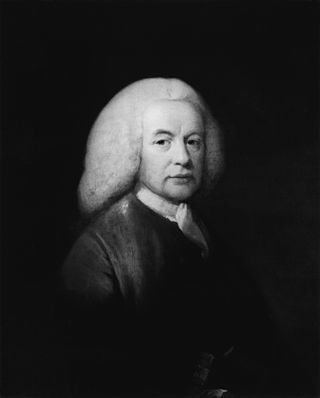
James Parsons FRS was an English physician, antiquary and author.
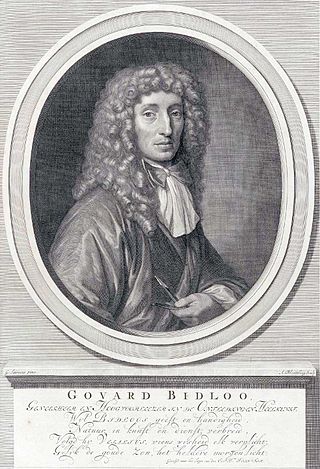
Govert Bidloo or Govard Bidloo was a Dutch Golden Age physician, anatomist, poet and playwright. He was the personal physician of William III of Orange-Nassau, Dutch stadholder and King of England, Scotland and Ireland.

Alexander Monro of Craiglockhart and Cockburn was a Scottish anatomist, physician and medical educator. He is typically known as Alexander Monro Secundus or Junior to distinguish him as the second of three generations of physicians of the same name. His students included the naval physician and abolitionist Thomas Trotter. Munro was from the distinguished Monro of Auchenbowie family. His major achievements included, describing the lymphatic system, providing the most detailed elucidation of the musculo-skeletal system to date and introducing clinical medicine into the curriculum. He is known for the Monro–Kellie doctrine on intracranial pressure, a hypothesis developed by Monro and his former pupil George Kellie, who worked as a surgeon in the port of Leith.
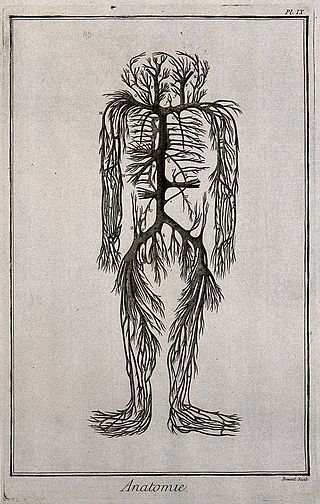
The Evelyn tables are a set of four anatomical preparations on wooden boards that are thought to be the oldest anatomical preparations in Europe. They were acquired by John Evelyn in Padua in 1646 and later donated by Evelyn to the Royal Society. They are currently owned by the Royal College of Surgeons, and displayed there at the Hunterian Museum in London. Six similar tables are held by Royal College of Physicians, brought to London from Italy by John Finch.
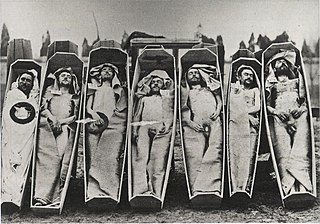
A cadaver or corpse is a dead human body. Cadavers are used by medical students, physicians and other scientists to study anatomy, identify disease sites, determine causes of death, and provide tissue to repair a defect in a living human being. Students in medical school study and dissect cadavers as a part of their education. Others who study cadavers include archaeologists and arts students. In addition, a cadaver may be used in developing and the evaluation of surgical instruments.

Arthur Jacob (1790–1874) was an Irish ophthalmologist. He is known for founding several hospitals, a medical school, and a medical journal. He contributed to science and academia through his 41-year term as Professor of Anatomy at the Royal College of Surgeons in Ireland (RCSI) and as the first Irish ocular pathologist. He was elected President of RCSI in 1837 and 1864.
James Keill was a Scottish physician, philosopher, medical writer and translator. He was an early proponent of mathematical methods in physiology.
Timothy Clarke was an English physician, a founding Fellow of the Royal Society.
Patrick Blair FRS (ca.1670–1728) was a Scottish surgeon, anatomist and botanist, and a Fellow of the Royal Society.

James Macartney was an anatomist. He began life as an Irish volunteer in 1780, and was afterwards educated at the endowed classical school at Armagh, and then at a private school. He was associated for a time with the Sheares brothers and Lord Edward Fitzgerald, the United Irishmen but, being dissatisfied with their programme, he cut himself adrift and began to study medicine.
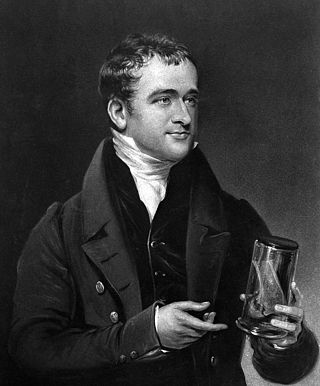
Herbert Mayo, M.D., was a British physiologist, anatomist and medical writer.
Samuel Clossy MB MD was a pioneering Irish anatomist and the first college professor of a medical subject in North America.
References
- 1 2 3 4 Goodwin 1894.
- ↑ "Fellow details". Royal Society. Retrieved 26 January 2016.
- Attribution
![]() This article incorporates text from a publication now in the public domain : Goodwin, Gordon (1894). "Molines, Allan". In Lee, Sidney (ed.). Dictionary of National Biography . Vol. 38. London: Smith, Elder & Co.
This article incorporates text from a publication now in the public domain : Goodwin, Gordon (1894). "Molines, Allan". In Lee, Sidney (ed.). Dictionary of National Biography . Vol. 38. London: Smith, Elder & Co.